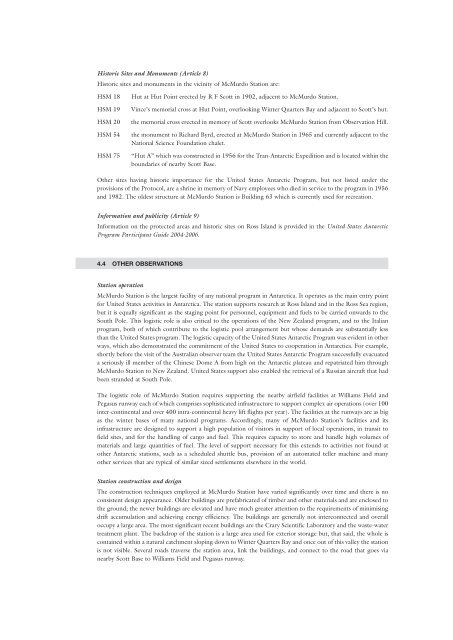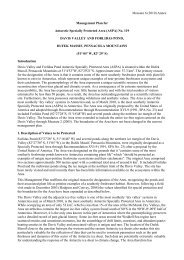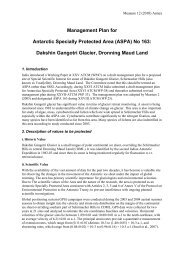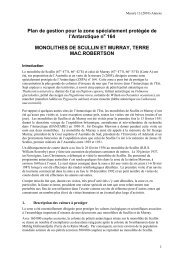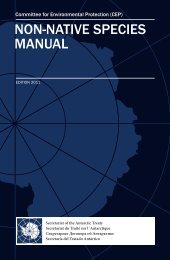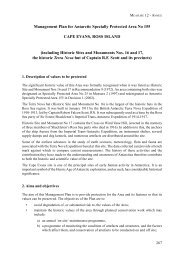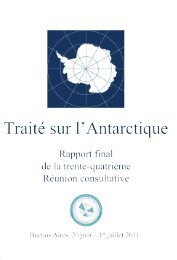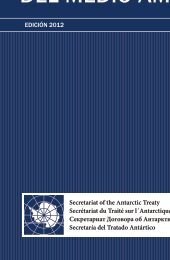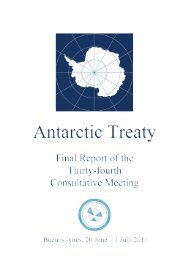Scott Base and McMurdo Station - Antarctic Treaty Secretariat
Scott Base and McMurdo Station - Antarctic Treaty Secretariat
Scott Base and McMurdo Station - Antarctic Treaty Secretariat
You also want an ePaper? Increase the reach of your titles
YUMPU automatically turns print PDFs into web optimized ePapers that Google loves.
Historic Sites <strong>and</strong> Monuments (Article 8)Historic sites <strong>and</strong> monuments in the vicinity of <strong>McMurdo</strong> <strong>Station</strong> are:HSM 18HSM 19HSM 20HSM 54HSM 75Hut at Hut Point erected by R F <strong>Scott</strong> in 1902, adjacent to <strong>McMurdo</strong> <strong>Station</strong>.Vince’s memorial cross at Hut Point, overlooking Winter Quarters Bay <strong>and</strong> adjacent to <strong>Scott</strong>’s hut.the memorial cross erected in memory of <strong>Scott</strong> overlooks <strong>McMurdo</strong> <strong>Station</strong> from Observation Hill.the monument to Richard Byrd, erected at <strong>McMurdo</strong> <strong>Station</strong> in 1965 <strong>and</strong> currently adjacent to theNational Science Foundation chalet.“Hut A” which was constructed in 1956 for the Tran-<strong>Antarctic</strong> Expedition <strong>and</strong> is located within theboundaries of nearby <strong>Scott</strong> <strong>Base</strong>.Other sites having historic importance for the United States <strong>Antarctic</strong> Program, but not listed under theprovisions of the Protocol, are a shrine in memory of Navy employees who died in service to the program in 1956<strong>and</strong> 1982. The oldest structure at <strong>McMurdo</strong> <strong>Station</strong> is Building 63 which is currently used for recreation.Information <strong>and</strong> publicity (Article 9)Information on the protected areas <strong>and</strong> historic sites on Ross Isl<strong>and</strong> is provided in the United States <strong>Antarctic</strong>Program Participant Guide 2004-2006.4.4 OTHER OBSERVATIONS<strong>Station</strong> operation<strong>McMurdo</strong> <strong>Station</strong> is the largest facility of any national program in <strong>Antarctic</strong>a. It operates as the main entry pointfor United States activities in <strong>Antarctic</strong>a. The station supports research at Ross Isl<strong>and</strong> <strong>and</strong> in the Ross Sea region,but it is equally significant as the staging point for personnel, equipment <strong>and</strong> fuels to be carried onwards to theSouth Pole. This logistic role is also critical to the operations of the New Zeal<strong>and</strong> program, <strong>and</strong> to the Italianprogram, both of which contribute to the logistic pool arrangement but whose dem<strong>and</strong>s are substantially lessthan the United States program. The logistic capacity of the United States <strong>Antarctic</strong> Program was evident in otherways, which also demonstrated the commitment of the United States to cooperation in <strong>Antarctic</strong>a. For example,shortly before the visit of the Australian observer team the United States <strong>Antarctic</strong> Program successfully evacuateda seriously ill member of the Chinese Dome A from high on the <strong>Antarctic</strong> plateau <strong>and</strong> repatriated him through<strong>McMurdo</strong> <strong>Station</strong> to New Zeal<strong>and</strong>. United States support also enabled the retrieval of a Russian aircraft that hadbeen str<strong>and</strong>ed at South Pole.The logistic role of <strong>McMurdo</strong> <strong>Station</strong> requires supporting the nearby airfield facilities at Williams Field <strong>and</strong>Pegasus runway each of which comprises sophisticated infrastructure to support complex air operations (over 100inter-continental <strong>and</strong> over 400 intra-continental heavy lift flights per year). The facilities at the runways are as bigas the winter bases of many national programs. Accordingly, many of <strong>McMurdo</strong> <strong>Station</strong>’s facilities <strong>and</strong> itsinfrastructure are designed to support a high population of visitors in support of local operations, in transit tofield sites, <strong>and</strong> for the h<strong>and</strong>ling of cargo <strong>and</strong> fuel. This requires capacity to store <strong>and</strong> h<strong>and</strong>le high volumes ofmaterials <strong>and</strong> large quantities of fuel. The level of support necessary for this extends to activities not found atother <strong>Antarctic</strong> stations, such as a scheduled shuttle bus, provision of an automated teller machine <strong>and</strong> manyother services that are typical of similar sized settlements elsewhere in the world.<strong>Station</strong> construction <strong>and</strong> designThe construction techniques employed at <strong>McMurdo</strong> <strong>Station</strong> have varied significantly over time <strong>and</strong> there is noconsistent design appearance. Older buildings are prefabricated of timber <strong>and</strong> other materials <strong>and</strong> are enclosed tothe ground; the newer buildings are elevated <strong>and</strong> have much greater attention to the requirements of minimisingdrift accumulation <strong>and</strong> achieving energy efficiency. The buildings are generally not interconnected <strong>and</strong> overalloccupy a large area. The most significant recent buildings are the Crary Scientific Laboratory <strong>and</strong> the waste-watertreatment plant. The backdrop of the station is a large area used for exterior storage but, that said, the whole iscontained within a natural catchment sloping down to Winter Quarters Bay <strong>and</strong> once out of this valley the stationis not visible. Several roads traverse the station area, link the buildings, <strong>and</strong> connect to the road that goes vianearby <strong>Scott</strong> <strong>Base</strong> to Williams Field <strong>and</strong> Pegasus runway.


